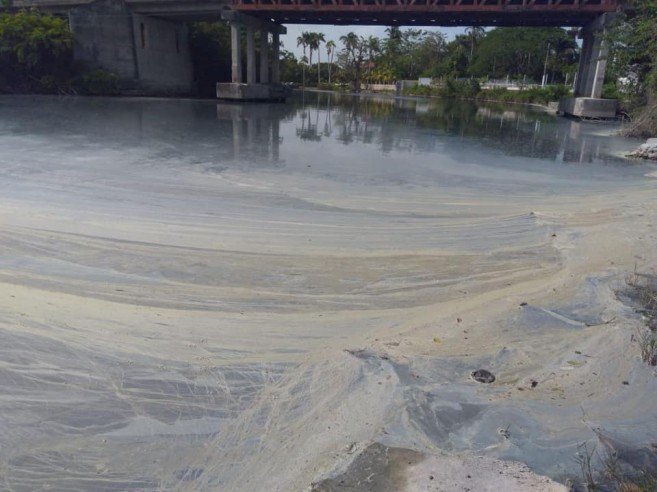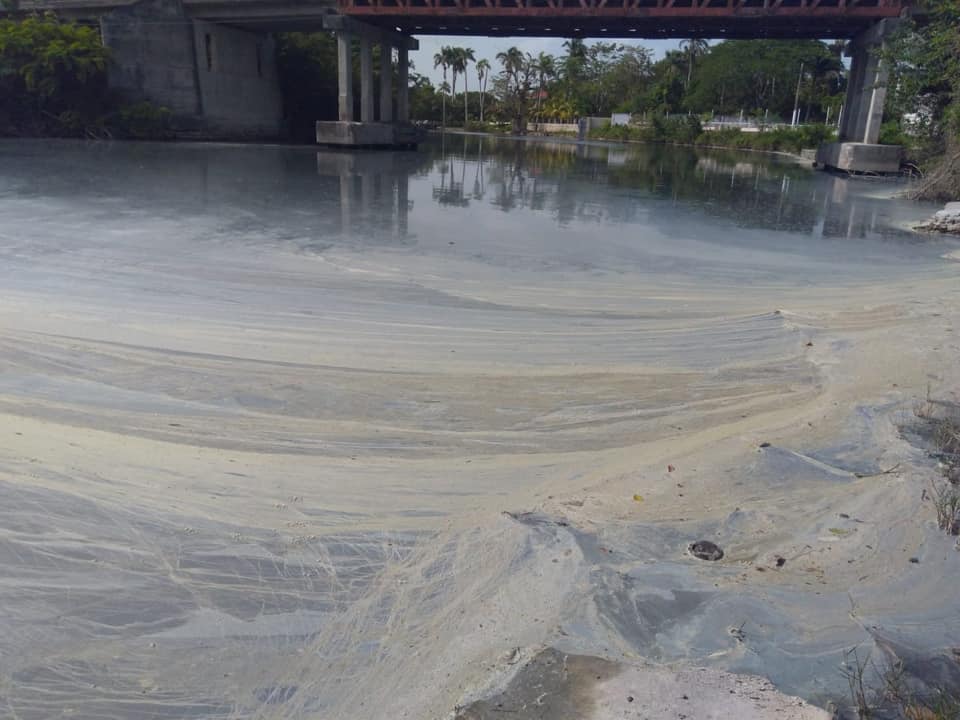Belmopan. September 6, 2019. The public is advised on the condition of the New River and updated on the work that has and will continue to be done by the Department of the Environment to address the situation as best as possible.
The Department of the Environment (DOE) has continuously monitored the effluent discharge throughout the country into waterways and the sea using the Effluent Limitations Regulations and the Environmental Protection Act as a legal basis. No industry is allowed to discharge toxic compounds in any concentration. Big and small industries are allowed, however, to discharge non-toxic compounds in concentrations that are considered safe for the environment. These compounds include nitrates, phosphates, dissolved organic matter and sulphates which are found in most industrial and household chemicals including surfactants, detergents and shampoos. Nitrates and phosphates are also found in fertilizer. Discharge of these non-toxic compounds is done through the disposal of wastewater (known as effluent) into waterways, or from agricultural run-off following rains, and must be within legal (safe) limits.
The DOE has continuously monitored the effluent discharge of ASR-BSI and other major industries along the New River, which has resulted in major reductions in the concentration of these non-toxic compounds. However, the temperature and sulphates of the ASR-BSI effluent remains a challenge, but greater emphasis has now been placed on technology to bring these within limits. It is important for the public to understand that ASR-BSI is but one entity discharging effluent into the New River. The cumulative discharge of every other entity including other factories, businesses, hotels, restaurants, all the households, schools, offices also results in a large amount of non-toxic compounds going into the New River through wash water, kitchen water, bathroom water, and other types of wastewater including sewage soak-away. The release of effluent is the same on most other rivers in Belize, but no other river currently faces the problems being experienced on the New River.
Why is only the New River facing this problem?
a) The New River is the only river in Belize that is relatively flat from headwaters to sea. The land over which the New River flows is slightly undulating with no significant sloping to force strong water flow. Elevation at the New River Lagoon is around 0 metres and at the sea it is also 0 metres, but between these two points the land over which it flows rises and falls by several meters. For example, at the very mouth of the New River Lagoon the elevation is around 5 metres and at San Estevan the land rises to around 9 metres. The lack of strong sloping means that the New River is very slow flowing and because there are several high points along its path which constrain water flow, it means that it is vulnerable to stagnation at many points when flow is limited by drought. Compare this to the Rio Hondo which starts at an elevation of close to 250 metres and ends up at the sea at 0 metres, which gives it a strong flow even at low water levels. Please see Figures 1 and 2 in the supporting information below. Since rainfall is the main source of water for the New River, any lack of rainfall for extended periods will result in stagnation at many points along the New River, and this is what is currently being experienced. During severe stagnation the New River, as with any river, could be reduced to a series of independent stagnant pools. During stagnation, the dissolved oxygen is naturally reduced and results in anoxic conditions that lead to the generation of a bio-film on the surface and the generation of hydrogen sulfide gas that smells like rotten eggs. These natural symptoms of stagnation are worsened when non-toxic compounds such as nitrates and phosphates are already present in the system since they contribute to rapid algal growth (basically a fertilization effect) and a further decline in dissolved oxygen as the plant matter decays. Without sufficient oxygen in the water, fishes suffocate. Stagnation is further worsened when the water temperature increases due to hot weather since this leads to further lowering of dissolved oxygen.
b) The New River catchment is currently facing the worse drought seen in recent times. Rainfall data from the National Meteorological Service shows that the rainy season of 2019 has seen the lowest rainfall of any rainy season since 1983. Please see Figure 3 in supporting information. In fact, the rainy season of 2019 has received as little as 100 mm of rainfall per month, which actually qualifies it to be a dry season by definition. With the preceding dry season earlier on in the year, in effect what is happening is that the entire year has been one long dry season up to this point. This extreme drought combined with the intrinsic vulnerability of the New River as described above are major factors that are leading to the problems being observed.
While we cannot change the river or the weather, what can be done about the problem now?
In extreme drought conditions the river will stagnate and become unsightly and unsafe for aquatic life naturally, with or without the input of effluent. However, effluent input makes the situation worse. So the primary task of the DOE is to continue to work with industries to improve the quality of their effluent. The DOE will also expand its reach to work with other non-industrial sources of effluent such as restaurants and hotels to provide advice on how they can improve the quality of their wastewater. The DOE will also work towards the development of a watershed management plan that will be aimed primarily at minimizing the agricultural run-off into the New River through conservation of riparian areas. These are not immediate solutions, however.
Some immediate solutions that are being procured at the moment include the use of Aluminum sulphate and Effective Micro-organisms which when inputted into the stagnated sections of the river near to settlements, is expected to improve the water quality by coagulating or digesting the organic matter thereby reducing the emission of hydrogen sulfide. However, this will not improve the chances of survival of aquatic life as it will not boost dissolve oxygen in the water. It will also likely result in an immediate burst of hydrogen sulfide that will last for a while before dissipating. The smell of rotten eggs is expected to then go away after this burst. Another immediate solution being employed is aeration of the stagnated areas using pumps. As above, this will likely lead to an immediate burst of hydrogen sulfide but thereafter conditions are expected to improve. Another immediate solution already underway is the physical clean up of dead fish and refuse along the river. Please see photos in supporting information. These solutions while immediate, are not going to overcome the overwhelming influence of the drought affecting the New River and will not make it flow again. Only rain will accomplish a return to normalcy as we know it.
More expertise and boots on the ground to tackle the problem is also being procured at the moment. There are Belizeans who have work experience in Mexico and elsewhere tackling similar problems on an industrial scale who are being contracted to assist with advising on and executing recommended solutions.
Monitoring of hydrogen sulfide in the air will be performed with the assistance of the Belize Natural Energy Ltd using their specialized equipment. This will help to assess the usefulness of the immediate solutions outlined above.
The Department of the Environment will also be forming a taskforce to coordinate efforts to monitor and tackle the immediate problems as best as possible. They will also be providing frequent updates through press releases over coming days so as to keep the public informed. The public is reminded that in the absence of information reaching each and every person, there is still much happening and much work being carried out by the DOE and others to monitor and find solution to the problem being faced on the New River.


